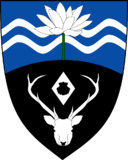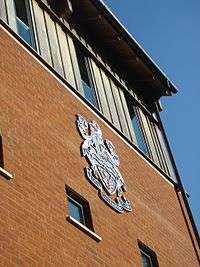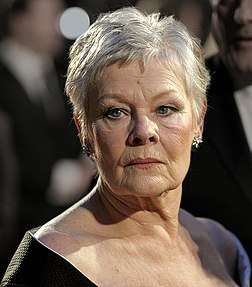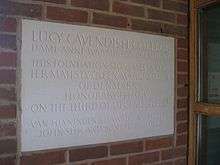Lucy Cavendish College, Cambridge
| Lucy Cavendish College | |||||||||||||||||||
|---|---|---|---|---|---|---|---|---|---|---|---|---|---|---|---|---|---|---|---|
| Cambridge University | |||||||||||||||||||
|
| |||||||||||||||||||
 | |||||||||||||||||||
|
| |||||||||||||||||||
| Location | Lady Margaret Road, Cambridge (Map) | ||||||||||||||||||
| Established | 1965 | ||||||||||||||||||
| Named for | Lucy Cavendish | ||||||||||||||||||
| Gender | Women | ||||||||||||||||||
| Age restriction | Aged 21 or over | ||||||||||||||||||
| President | Jackie Ashley | ||||||||||||||||||
| Undergraduates | 140 | ||||||||||||||||||
| Postgraduates | 210 | ||||||||||||||||||
| Endowment | £11.1m (as of 30 June 2017)[1] | ||||||||||||||||||
| Website |
www | ||||||||||||||||||
| Students' Union |
lucycavendishsu | ||||||||||||||||||
| Boat club |
lucy-cav | ||||||||||||||||||

Lucy Cavendish College is a constituent college of the University of Cambridge which admits only postgraduates and undergraduates aged 21 or over. It only accepts female students and fellows, making the college one of only three women-only university colleges in England.[2][3]
The college is named in honour of Lucy Cavendish (1841–1925), who campaigned for the reform of women's education.[4]
History
The college was founded in 1965 by female academics of the University of Cambridge who believed that the university offered too few and too restricted opportunities for women as either students or academics. Its origins are traceable to the Society of Women Members of the Regent House who are not Fellows of Colleges (informally known as the Dining Group) which in the 1950s sought to provide the benefits of collegiality to its members who, being female, were not college fellows.[5] At the time there were only two women's colleges in Cambridge, Girton and Newnham, insufficient for the large and growing numbers of female academic staff in the university.[6]
The college was named in honour of Lucy Caroline Cavendish, a pioneer of women's education and the great aunt of one of its founders, Margaret Braithwaite.[4] First formally recognised as the Lucy Cavendish Collegiate Society, it moved to its current site in 1970, received consent to be called Lucy Cavendish College in 1986, and gained the status of a full college of the university by Royal Charter in 1997.[7]
The first president of the college, from 1965 to 1970, was Anna McClean Bidder, one of the founding members of the Dining Group and a zoologist specialising in cephalopod digestion;[6] this accounts for the presence of the nautilus shell in the college coat of arms.[8] She was succeeded by Kate Bertram until 1979, Phyllis Hetzel (Lady Bowden),[9] Dame Anne Warburton (the first female British ambassador in 1976), Baroness Perry of Southwark, Dame Veronica Sutherland, Janet Todd and Jackie Ashley.
The current and 9th President of Lucy Cavendish is Madeleine Atkins, who took up the post in 2018.
Student body
Lucy Cavendish has over 350 students, approximately 40% of whom are undergraduates and 60% graduates.[10] Students originate from over 60 different countries, making it a distinctly international college. The majority of its undergraduates have applied directly, but in comparison to the university-wide averages the college makes proportionately more offers to the university's 'pool' applicants.[11] The college website states that "Students from every corner of the UK mix with students from around the world. Students with 'Access' qualifications interact with students who have studied for A-levels and the International Baccalaureate. Former bankers, singers, journalists and police officers mix with recent graduates of universities from around the world. Women come at any age to study any subject offered by the University."[12] The average age of students in the college is 22.
Lucy Cavendish students are also called "Lucians".
Academic performance
The overall examination results of the college's comparatively few undergraduates has improved drastically in later years compared to other Cambridge colleges, with Lucy Cavendish recently making a record-breaking leap of 8 places in the Tompkins table – the best result for any mature college in the history of the rankings.[13][14][15]
History
For the first few years of the college's existence it occupied rooms first in Silver Street and then in Northampton Street. In 1970 it moved to its current site on the corner of Madingley Road and Lady Margaret Road, near Westminster College and St John's College, which had provided some of the land.[16]
In 1991 the college bought Balliol Croft, a neighbouring house to its grounds and former home of the economist Alfred Marshall and his wife Mary Paley Marshall, with whom he wrote his first economics textbook. The building was renamed Marshall House in his honour and used for student accommodation until 2001 when it was converted back to its original layout and used as the President's Lodge.[17] Meanwhile, the majority of the college's buildings, including Warburton Hall and the library, were completed in the 1990s.[16]

List of presidents
- Anna McClean Bidder (1965 to 1970); Inaugural president
- Kate Bertram (1970 to 1979)
- Phyllis Hetzel (1979 to 1984)
- Dame Anne Warburton (1985 to 1994)
- Pauline Perry, Baroness Perry of Southwark (1994 to 2001)
- Dame Veronica Sutherland (2001 to 2008)
- Janet Todd (2008 to 2015)
- Jackie Ashley (2015 to 2018)
- Madeleine Atkins (September 2018 to present)
Notable alumnae
 Dame Judi Dench is an Honorary Fellow of the collegeNoeleen Heyzer, Executive Director of the United Nations Development Fund for Women (UNIFEM)
Dame Judi Dench is an Honorary Fellow of the collegeNoeleen Heyzer, Executive Director of the United Nations Development Fund for Women (UNIFEM) This stone was laid by Queen Margrethe of Denmark in Dec. 1993
This stone was laid by Queen Margrethe of Denmark in Dec. 1993
Honorary Fellows
- Dame Judi Dench
- Anna Ford
- Cynthia Glassman
- Lady Grantchester
- P.D. James
- Queen Margrethe of Denmark
- Dame Anne Owers
- Pauline Perry, Baroness Perry of Southwark
- Professor Alison Richard
- Dame Stella Rimington
- Dame Cath Tizard
- Sandi Toksvig
- Claire Tomalin
- Jean Barker, Baroness Trumpington
- Martina Navratilova
- Ali Smith
- Professor Jane Clarke FRS
References
- ↑ "Annual report and Financial Statements for the year ended 30 June 2017" (PDF). Lucy Cavendish College, Cambridge. Retrieved 3 August 2018.
- ↑ "Visiting Academics – Lucy Cavendish". Retrieved 14 September 2014.
- ↑ "Kodate Kodate & Kodate 2010" (PDF). Retrieved 14 September 2014.
- 1 2 Renfrew, Jane M. "Who was Lucy Cavendish?". Rooms of Our Own – Lucy Cavendish College. Archived from the original on 7 July 2011. Retrieved 1 March 2012.
- ↑ "Papers of the Dining Group 1951–1966". London Metropolitan University.
- 1 2 Warburton, Anne (9 October 2001). "Anna Bidder obituary". The Independent. London.
- ↑ "Statutes for Lucy Cavendish College in the University of Cambridge" (PDF). Lucy Cavendish College. 1997. Retrieved 1 March 2012.
- ↑ "The Lucy Cavendish College Shield of Arms". Lucy Cavendish College. Retrieved 24 February 2012.
- ↑ "Women of Cambridge". University of Cambridge. 5 June 2008. Retrieved 26 March 2011.
- ↑ "Supporting Students". Lucy Cavendish College.
- ↑ "Application statistics". University of Cambridge. Retrieved 14 September 2014.
- ↑ "Lucy Cavendish College Information". Lucy Cavendish College. Retrieved 14 September 2014.
- ↑ "Analysis: What does it take to top Tompkins?". Varsity. 11 May 2010. Retrieved 27 July 2017.
- ↑ "Trinity tops Tompkins Table for seventh straight year". Varsity. 14 September 2014. Retrieved 27 July 2017.
- ↑ "Lucy Cavendish moves up 8 places in the Tompkins Table". Lucy Cavendish College.
- 1 2 "Lucy Cavendish College Site and Buildings" (PDF). Lucy Cavendish College. Archived from the original (PDF) on 27 September 2011. Retrieved 14 September 2014.
- ↑ "Cambridge 2000 – Lucy Cavendish College: Madingley Road: Marshall House (Balliol Croft)". Cambridge 2000.
External links
| Wikimedia Commons has media related to Lucy Cavendish College, Cambridge. |